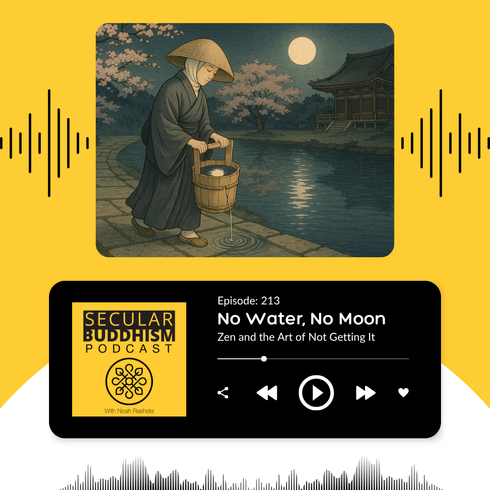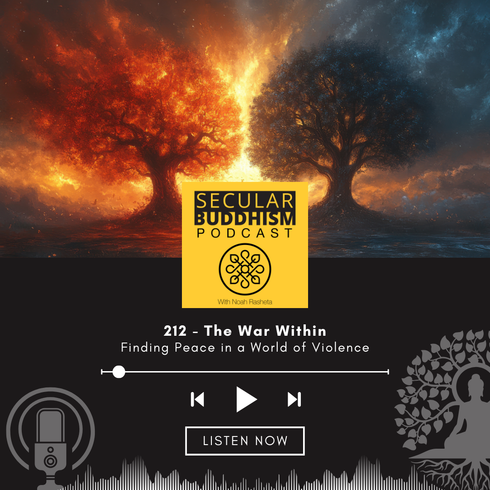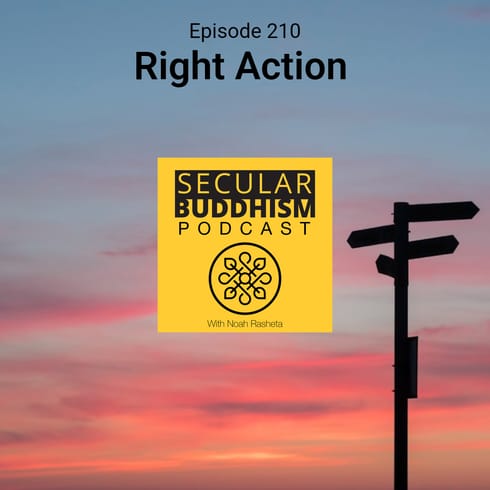Developing the four foundations of mindfulness helps us to remove the conceptual constructs that often blind us from seeing reality as it is. Imagine being able to see things as they really are, free from our ideas and concepts. This is the very liberation we refer to as “enlightenment”. In this episode, I will discuss the four foundations of mindfulness and how each foundation can help us to gain more clarity and understanding about the nature of reality.
Subscribe to the podcast on:
iTunes – https://itunes.apple.com/us/podcast/secular-buddhism/id1071578260
SoundCloud – https://soundcloud.com/secularbuddhism
TuneIn – http://tunein.com/radio/Secular-Buddhism-p823114/
Stitcher – http://www.stitcher.com/s?fid=80132&refid=stpr
New – Join our Online Weekly Sangha – https://www.remind.com/join/sbsangha
Transcription of the podcast episode:
Please excuse any typo’s, I use a transcription service to create a text version of the audio recording. If there are any issues with the transcription, please let me know.
Welcome to another episode of The Secular Buddhism podcast. This is episode #53. I am your host, Noah Rasheta and today I’m talking about: The Four Foundations of Mindfulness (Intro Music break 2-3 seconds).
As you may know, Mindfulness is one of the most basic practices of Buddhism. It’s one of the spokes of the Eight Fold Path (I talked about the eightfold path in episode 41 “Life on the Buddhist Path”). Mindfulness is a hot topic right now. I believe it was Time magazine that not long ago had a cover that said mindfulness has gone mainstream. A lot of people are intersted in mindfulness although they may not be interested in other aspects of Buddhist practice. Mindfulness practice is overlapping with a lot of therapeutic practices in psychology. While many people associate Mindfulness with meditation, there’s more to it than just meditation. In fact, the Buddha taught that we should practice mindfulness at all times, not just while meditating. The reason mindfulness is such a skillful practice is because through mindfulness (through awareness) we can learn to perceive the nature of reality, the nature of things being interdependent and impermanent and that proper perspective of reality helps us to cut through delusions and unhealthy attachments or clinging.
Mindfulness as a practice, goes beyond just paying close attention to things…It’s a form of pure awareness of reality just as it is. Awareness without judgements or concepts. To see reality through this mindful lens, it takes practice. It takes resolve and effort and all the other spokes of the eightfold path.
The Four foundations I want to discuss in this episode are frames of reference, usually looked at one at a time in our mindfulness practice. So you start with mindfulness of the breath and end up with mindfulness of everything. These four foundations are often taught in the context of meditation, but they can help with other practices too.
MINDFULNESS OF BODY
The first foundation is mindfulness of body. This foundation centers on the experience of the body. This is an awareness of the body as body—something experienced as breath and flesh and bone. It is not “my” body. Think about the aspects of the body that you don’t control. If it’s “my” body, then why can’t I will it to sleep or to wake up…why can’t I control my heart rate or the speed of my metabolism? Why can’t I control my body temperature? Alan Watts we are a do-happening…. So we don’t view the body as a form that we are inhabiting. We just view it as an experience we are having. The body is just the body in the same way that my hand is just my hand and yet there is a lot going on in the inner workings of my hand.
Most mindfulness exercises focus on the breath for the foundation of body. This is experiencing breath and observation of breathing as a thing that’s happening vs just a thing I control. It is not about thinking about the breath or coming up with ideas or concepts about breath. We just observe and we watch this process that is happening to us.
The idea is that as the ability to maintain awareness of our breathing gets stronger, we become more aware of the whole body as a thing that’s just happening. Think about it, right now, there are incredible processes happening with your body and are outside of our sphere of awareness. Hair is growing, cells are dying and being replaced by new cells. Blood is flowing, oxygen is being carried into your muscles and tissue while carbon dioxide is being removed. There are electrical signals firing off in your brain causing you to think certain things, chemicals are released that cause you to feel certain things…There is a lot of happening that gives off the impression of doing. There is no doing without the happening and no happening without the doing. It’s absolutely incredible when you sit and observe what is happening right now with your body.
In some schools of Buddhism, this form of awareness includes movement. Walking meditation, chanting or rituals are all opportunities to be mindful of the body as it moves or makes sounds. This practice helps us to be more mindful even when we aren’t meditating. I think many schools of martial arts emerged from this practice of bringing meditative focus to body movement. So many of our day to day activities can be used as body awareness practice.
MINDFULNESS OF FEELINGS
The second foundation is mindfulness of feelings, this includes both physical and mental experiences or sensations. In meditation, we learn to become observers of the feelings and sensations that arise. They come and go, they arise, linger and then go away or get replaced by other thoughts or feelings and we learn to just observe them without judgments and without identifying with them. This is why we often say “I’m feeling tired” as opposed to “I am tired”. These are not “my” feelings, they’re just feelings. When I feel an itch, I don’t say “my itch”, I think oh, my nose has an itch, there is no identifying with the itch, but with feelings, we usually make the mistake of identifying with the feeling. Remember: there are just feelings.
Learning to observe our feelings can sometimes be uncomfortable. The feelings that come up when we’re just observing, can surprise us. We seem to have the incredible ability to ignore our own feelings, especially negative ones like anxiety or anger and then when we sit there and start looking, it’s like they jump out at us and they say “surprise”, I’m here! I’ve been hiding here, didn’t you see me? Haha. Ignoring the feelings or sensations we don’t like is unhealthy. As we learn to observe and fully acknowledge our feelings, we also see how feelings dissipate because feelings, like all things, are impermanent. Feeling tones…pleasant, unpleasant or neutral. Notice how our mental and physical sensory experiences all have a feeling tone. Through observation, you can become really skilled at identifying these tones in your ongoing experiences.
MINDFULNESS OF MIND
The third foundation is mindfulness of mind or consciousness. This foundation concerns watching one’s general mental state. In other words, the awareness of our feelings leads to an awareness of our mind. Without awareness or mindfulness…unseen pleasant feelings lead to craving, unseen unpleasant feelings lead to aversion or hatred and unseen neutral feelings lead to ignorance. The three poisons we often talk about in Buddhist practice. Understanding this correlation helps us to see how mindfulness can serve as a tool to break free from the habitual reactivity we have to our feelings. It’s skillful to know, am I experiencing a mental state of clinging or craving? A mental state of aversion of hatred? Is my mental state focused or scatter brained? This is what it means to be mindful of the mind. What overall mental state am I experiencing? Imagine being able to have more control over our words and actions simply because of the awareness of our mental state. I may be able to pause and refrain from saying something or doing something that I may later regret because I know that my current mental state is not appropriate for what I’m about to say or do… Theres real power in having a keen awareness of our mental states. So many people say or do things that they later regret once they are in another state of mid that is more skillful or healthy.
Another way of thinking of this foundation is “mindfulness of mental states.” Like sensations or feelings, our states of mind come and go. Sometimes we are sleepy; sometimes we are restless. We can learn to observe our mental states, without judgment or opinion. As we learn to see them come and go, we start to understand how insubstantial they are and then they no longer have such power of us.
MINDFULNESS OF PHYSICAL & MENTAL PROCESSES
The fourth foundation is mindfulness of physical and mental processes. This is also sometimes referred to as the mindfulness of all things. This stage integrates the precious three stages. This is where we begin to observe the totality of all the physical and mental processes that are taking place. It’s in this stage that we begin to observe the interplay of all things both physical and mental that are taking place. This is where we begin to notice and observe our “world”. My world, your world, we all live in our own world. Our worlds are influenced by ideas, beliefs, memories, and many more things. So in this foundation of mindfulness we open ourselves to the whole world, or at least the world that we experience. This is where we begin to see and experience “things as they are”. Things are what they are because of how we recognize them. So in this foundation we start to learn to see things in a deeper sense as inter -connected things. This is because that is. We start to see and understand the interdependent and impermanent nature of all things. We become mindful of the fact that there is no independent self, we are conditions by everything else/. The very world we perceive as our own, our ideas, our concepts, our beliefs, they are all conditioned by everything else, they all have causes and conditions and those causes and conditions also have causes and conditions and on and on and on.
Developing the four foundations of mindfulness removes the conceptual construct until we see things as they actually are. This is the very liberation we talk about as enlightenment. The ability to see things as they really are….namely interdependent and impermanent. There is nothing mystical or woo woo about any of this and yet with this clear and direct way of seeing, we become free, liberated from our conceptual conditioning. It’s an incredible way of being with reality. No longer caught up in the mental games that cause us so much unnecessary suffering.
Challenge for this week. Try to practice the four foundations of mindfulness: body, feelings, mind, and physical/mental processes (or all things)
If you want to learn more abut these ideas, these teachings come from the Satipatthana Sutta. The translation I enjoy reading is “In the Buddha’s Words: An anthology of discourses from the pali canon” by Bhikkhu Bodhi


